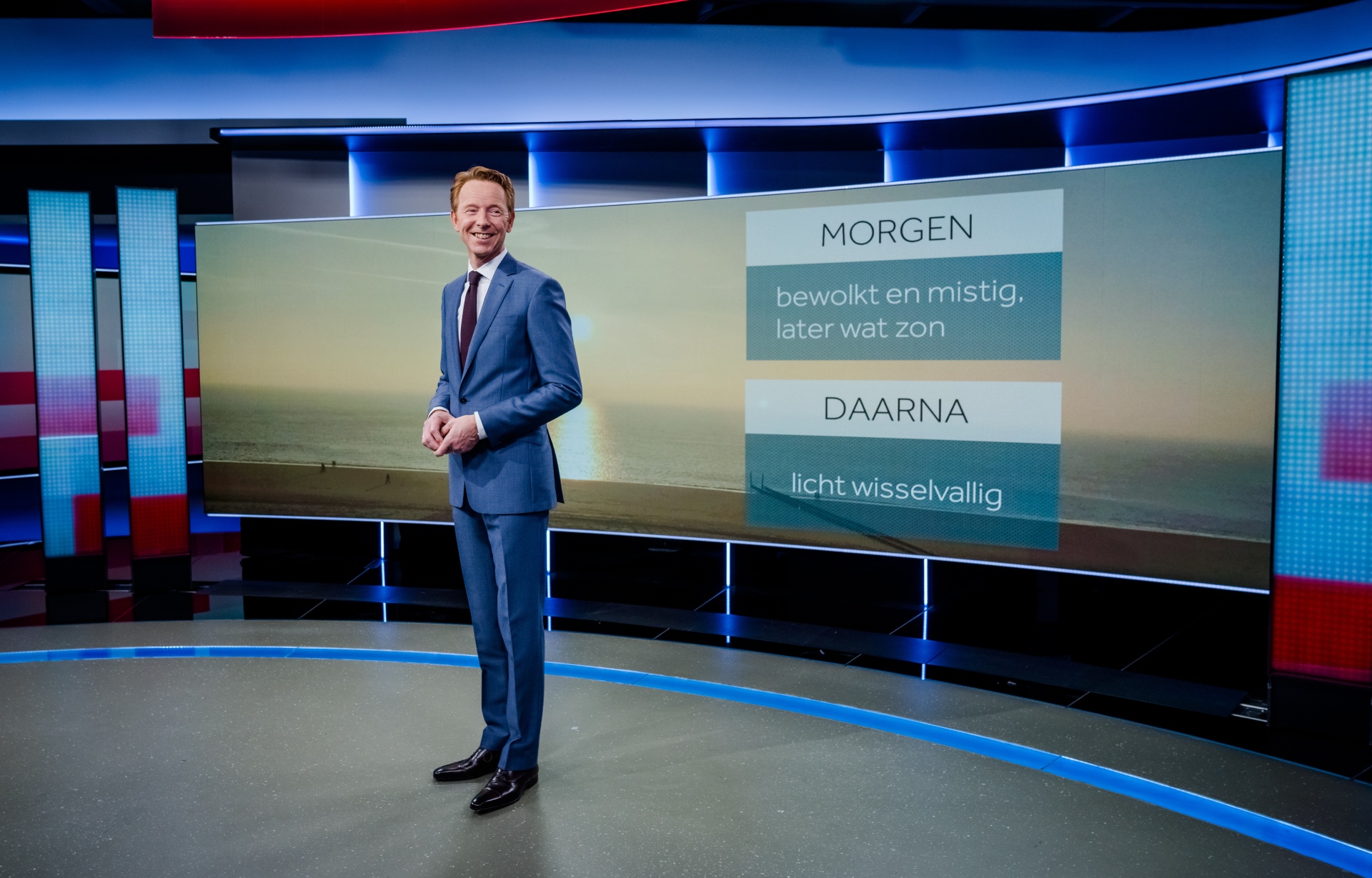Weerman en eredoctor Gerrit Hiemstra kan slecht tegen flauwekul
Weerman met passie, kennis én een heldere boodschap: zo kennen veel Nederlanders Gerrit Hiemstra, jarenlang presentator van het weerbericht aan het eind van het NOS-journaal. Nog steeds is hij gefascineerd door weerfenomenen en probeert hij de ernst van klimaatverandering over te brengen, al is zijn podium tegenwoordig anders. Op 24 mei ontvangt hij een eredoctoraat van de RUG voor zijn verdiensten in het aankaarten van klimaatverandering en haar ernstige gevolgen. De uitreiking vindt plaats tijdens de lustrumweek.
Tekst: Thomas Vos

‘Ik kan er echt slecht tegen als er flauwekul verteld wordt over klimaatverandering, als mensen met de waarheid aan de haal gaan en de werkelijkheid anders presenteren dan dat ie is. Al die desinformatie. Ik vind dat bijna crimineel eerlijk gezegd,’ vertelt Hiemstra vanuit zijn met natuurlijke materialen (kalk en hennep) gebouwde huis in het Friese Balk. ‘Die ergernis is, samen met mijn enthousiasme voor de wetenschappelijke kant van klimaatverandering, een belangrijke drijfveer voor mij om meer bewustzijn te creëren.’
Bekend van tv
Gerrit Hiemstra (Drachten, 1961) groeide als NOS-weerman uit tot bekende Nederlander. Voordat hij in ‘s lands huiskamers te zien was, studeerde hij agrotechniek in Wageningen, met als studierichting meteorologie. Hierna werkte hij eerst in de weerkamer van voormalig weerbedrijf Meteo Consult. Van 1998 tot en met 2023 was hij een van de hoofdpresentatoren van het NOS-weerbericht. Naast zijn werk als presentator bleef Hiemstra actief bij verschillende weerbedrijven. Tegenwoordig is hij eigenaar en consultant bij een adviesbureau dat innovatieve oplossingen op het gebied van weer en klimaat ontwikkelt. Hij is tevens mede-oprichter van Oarshûs, dat klimaatneutraal bouwen met natuurlijke materialen faciliteert. Zijn eigen huis vormde de inspiratiebron voor dit bedrijf.
Doodzenuwachtig
De stap naar televisie in 1998 verliep als volgt: ‘Via mijn werk kwam ik in de tweede helft van de jaren ‘90 in contact met de maker van het Agrarisch Journaal van de EO. Hij vroeg of wij misschien het weerbericht konden verzorgen, en dat leek mij wel wat. Na ruim een jaar dat te hebben gedaan, kwam in 1998 een vacature bij de NOS vrij. Ik stuurde een demoband op en mocht auditie komen doen. Ze hadden zoiets van ‘oh, die kan het al,’ maar ik was natuurlijk doodzenuwachtig. Ik heb toen maar wat gedaan, en dat vonden ze goed. In het begin was ik vooral de vaste invaller, later werd ik steeds meer de vaste weerman.’

In de camera kijken
Dat betekende dat Hiemstra twee volle dagen in de week werkzaam was als weerman, met een miljoenenpubliek op radio en tv: ‘In het begin keek ik naar anderen om te kijken hoe het moest, maar door de tijd heen ontwikkelde ik mijn eigen stijl. Daarmee word je geloofwaardiger voor de kijker. De spanningsboog is bovendien kort. Je moet echt presteren, want het is ook heel snel weer voorbij. Na een aantal jaren is dat een automatisme. Als ik nu bijvoorbeeld wordt geïnterviewd, heb ik altijd de neiging om net als bij het presenteren van het weer de camera in te kijken. Alleen is dat bij een interview dus juist niet de bedoeling, haha.’
Klimaatverandering
Hiemstra staat bekend als voorvechter in het creëren van meer bewustzijn van klimaatverandering. Niet alleen als presentator van het weer, ook daarbuiten, tijdens lezingen en workshops bijvoorbeeld: ‘Op een gegeven moment besefte ik echt dat dit een belangrijk thema werd. Ik voelde me ervoor verantwoordelijk om dit over te brengen aan het publiek, vanwege de ernst van de situatie. In het begin doe je dat een beetje onbewust, je krijgt er feedback op, maar op een gegeven moment word je je ook bewust van jouw rol en het publiek dat je kunt bereiken. Dan wordt het een bewuste keuze om meer bij klimaatverandering stil te staan.’
Herhaling
Om die materie te laten landen, is goede communicatie van belang, benadrukt Hiemstra: ‘Ik verwijs vaak naar goede bronnen die op een toegankelijke manier de wetenschap over klimaatverandering uit de doeken doen. De website van het IPCC, bijvoorbeeld. Het is bovendien belangrijk om de boodschap domweg te herhalen. ‘Ja, dit is echt zo,’ dat idee. De essentie van het verhaal blijven noemen… ik denk dat dit werkt. En houd het praktisch voor de toehoorder. Ik breng ze wel eens uit balans door bijvoorbeeld te zeggen: ‘stop met tanken.’ De essentie van het probleem is namelijk goed uit te leggen. Het komt omdat we benzine, diesel, kerosine, aardgas en steenkool verbranden. Dat is een vast rijtje dat ik afloop bij presentaties.’

Boodschap aan wetenschap
Als ontvanger van een RUG-eredoctoraat heeft Hiemstra een boodschap aan de wetenschap: ‘Sommige wetenschappers leggen één keer iets uit en laten het er dan bij. Maar op die manier breng je jouw boodschap niet goed over. Ik zal dit bij de uitreiking van het eredoctoraat ook meegeven aan de universiteit: ga meer vertellen over wat je doet! En niet alleen op wetenschappelijke congressen in onderzoekstaal, maar ook daarbuiten in gewone mensentaal. Het ligt echt niet aan de intellectuele capaciteiten van wetenschappers, maar het is wel een kwestie van doen, en met een paar trucs kom je al een heel eind.’
Wennen
Hoe vindt hij het tot slot zelf om een eredoctoraat te ontvangen? Hiemstra: ‘Ik moest er eerst even aan wennen. Wat heb ik nou weer aan mijn fiets hangen? Maar het is heel eervol om zo’n eredoctoraat te ontvangen. Ik ben zelf niet actief in de academische wereld, maar communiceer natuurlijk wel veel over de wetenschappelijke kant van klimaatverandering. Dat is een van de redenen waarom ik dit eredoctoraat ontvang. Een mooie erkenning.’
Lezing met Gerrit Hiemstra op 24 mei
De Faculty of Science and Engineering geeft Hiemstra het woord voor een lezing getiteld 'Science, let's talk about it' in de ochtend van 24 mei. De lezing is gratis toegankelijk, maar aanmelden is verplicht. Aanmelden kan via de website van Studium Generale Groningen.
